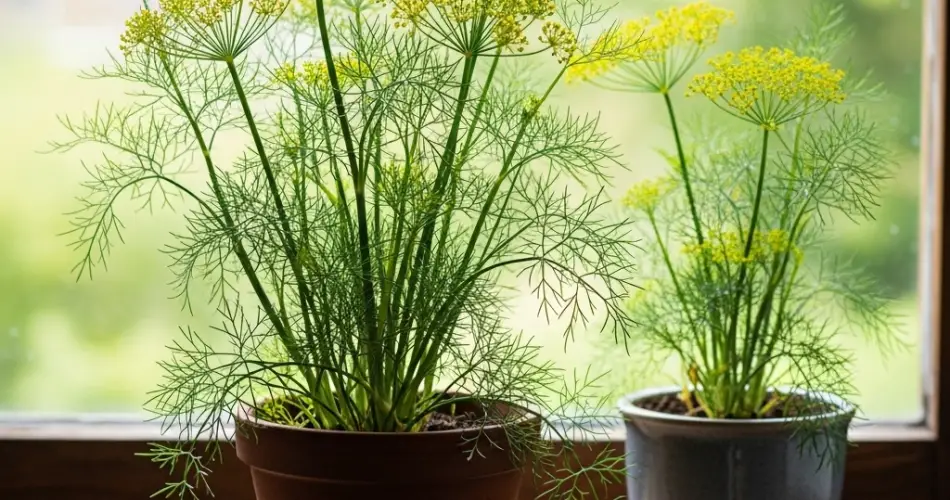Dill is a much-loved herb that brings a delicate, feathery texture and a burst of fresh, tangy flavor to countless dishes. Known for its use in pickling, soups, fish, and salads, dill is both versatile in the kitchen and attractive in the garden. The good news is that you don’t need a large outdoor plot to grow it. With the right setup, dill can thrive in containers, making it ideal for small patios, balconies, or even sunny windowsills. To achieve success, it’s important to understand its basic needs—particularly sunlight, soil, and water.
Choosing the Right Container
Because dill grows a long taproot, selecting the correct pot is the first step to success. The container should be at least 12 inches deep, though 14–16 inches is preferable. A deeper container prevents the roots from becoming restricted, which helps the plant grow taller and remain sturdy.
A pot with a diameter of 12–18 inches works well for either a few dill plants or a cluster. Multiple plants growing together can support each other as they get taller, while still leaving enough room for healthy root growth.
Always choose a pot with good drainage holes. Dill does not tolerate waterlogged soil, and excess moisture can lead to root rot.
The Best Soil for Dill
Dill thrives in light, well-draining soil. A standard all-purpose potting mix is a good starting point, but you can improve it by adding sand or perlite to increase drainage and prevent compaction. This is particularly important for dill’s deep root system.
Avoid heavy garden soil or clay-based mixes, as they can hold too much water and limit root development. The goal is to provide a loose, airy medium that encourages roots to grow straight down without obstruction.
Before planting, fill the container with your prepared soil, leaving about two inches of space from the rim. This gap makes watering easier and prevents soil from spilling out when you water.
Sunlight Needs
Dill is a sun-loving herb that requires at least 6–8 hours of direct sunlight daily. Place your container in the sunniest spot available, whether that’s a south-facing balcony, patio, or window.
If dill does not receive enough light, it tends to grow thin and leggy, with weak stems that struggle to remain upright. This not only affects the plant’s appearance but also its flavor. A strong supply of sunlight ensures fuller growth and more aromatic leaves.
For indoor growers, a supplemental grow light can be useful. Position it about 6–8 inches above the plants and keep it on for 12–14 hours a day to mimic natural sunlight.
Watering Tips
Proper watering is crucial for growing healthy dill in containers. The key is to keep the soil consistently moist but not soggy.
-
Check the soil: Insert your finger about an inch into the soil. If it feels dry at that depth, it’s time to water.
-
Water deeply: Each time you water, do so until liquid drains from the bottom of the container. This encourages deeper root growth and prevents shallow, weak roots.
-
Avoid overwatering: Dill dislikes sitting in waterlogged soil. Empty any saucers or trays under the pot after watering to prevent excess moisture from being trapped.
During hot summer days, especially when containers are in direct sun, you may need to water daily. In cooler weather, reduce frequency, always basing it on the soil’s moisture level rather than a fixed schedule.
Feeding Your Dill
Dill is not a heavy feeder, but container plants often need a bit of help since nutrients can wash out with regular watering. Apply a balanced liquid fertilizer once every four weeks during the growing season. Too much fertilizer encourages rapid, weak growth, so it’s better to feed lightly and consistently.
Harvesting Tips
Once dill plants are about 8 inches tall, you can start harvesting. Use scissors to snip the feathery leaves, beginning with the outer fronds and leaving the inner ones to continue growing. Regular harvesting not only supplies fresh herbs for your kitchen but also encourages the plant to produce more foliage.
If you’d like to harvest seeds, allow some plants to flower. Dill produces umbrella-shaped blooms that eventually form seed heads. Once the seed heads turn brown, cut them and place them in a paper bag to dry.
Common Problems to Watch For
-
Bolting: In hot conditions, dill may quickly produce flowers and seeds, which shortens leaf production. To delay bolting, harvest regularly and keep the soil evenly moist.
-
Weak stems: This usually indicates insufficient sunlight or overly rich soil. Adjust the light conditions and avoid overfeeding.
-
Pests: Aphids and caterpillars may occasionally feed on dill. A gentle spray of water or mild soap solution typically keeps them under control.
Final Thoughts
Growing dill in containers is a rewarding way to enjoy this flavorful herb, even if you have limited gardening space. By choosing the right pot, providing well-draining soil, ensuring plenty of sunlight, and maintaining a balanced watering routine, you’ll have strong, healthy dill plants ready to enhance your cooking.
With just a little care and attention, you can keep a steady supply of dill fronds for fresh garnishes, hearty soups, and pickling projects—all right from your balcony or kitchen windowsill.



